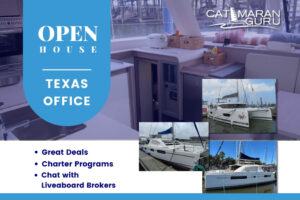Overseas Radio Network – Bahamas: Elbow Cay, Tahiti Beach, & Little Harbour

In the Overseas Radio Network Show 6, Segment 2, we’re talking about cruising destinations of the Bahamas:
- Elbow Cay
- Tahiti Beach
- Little Harbour
ESTELLE COCKCROFT: Hi, guys, we are back and we are talking about the beautiful Bahamas Islands. Gary just told us about Hope Town, one of his favorite little places. We used to do obviously a lot of sail schools there for 3 seasons. And so, Stephen, do you want to tell us a little about Hope Town and sailing around there?
For a transcript of this podcast, click “read more” below.
Elbow Cay
STEPHEN COCKCROFT: Yes, sailing around Hope Town which is actually Elbow Cay is really nice sailing. We use to use Elbow Cay and Hope Town for quite a few exercises. So one of the things we used to do…it is very, very shallow when you approach the mouth into the little enclosed harbour of Hope Town. It is almost like a totally enclosed bay with just one entrance coming in. And when you come in, it’s the only place that we could really teach transits which are 2 poles or 2 marks on the land which you get one above the other so that you know you are coming in on a straight line.
Also, inside Hope Town, because it is so popular, it has lots of moorings. And some people come down and spend 6 months. They’ll rent a mooring and won’t leave for 6 months. Actually becomes a transient population and live in Hope Town for half of the year. So in the season Hope Town’s population has a substantial spike in growth. And when hurricane season comes they all go home again.
Tahiti Beach
In the lee of Elbow Cay, as you come out of Hope Town and head south, it is very sheltered and the water is average of probable 8ft deep. So that’s where we used to do out man overboard drills and practice. Heading south, one of our “always” stops was a place called Tahiti Beach which is a great big sand bar. At high tide, it is just below the water and at low tide, it comes right out of the water.
So we use to spend a lot of time going down to the Tahiti Beach and anchoring off. And nothing nicer than sitting on the sand bar having sun downers. One thing that everyone should remember is that Tuesday nights is bingo nights at Jack’s in Hope Town.
ESTELLE: Yeah, that was the big social event of the week for all of us. Gary, another one of your favorites is the Little Harbour, I believe.
Little Harbour
GARY: Yes, I love Little Harbour. I think it is about 20 miles south of Hope Town and it’s got an interesting story behind it. Back in the 1950s, this professor, Randolph Johnston, was an art professor at a New England college. And he decided he wanted to go live on a tropical island. So he bought an old rotting schooner in 1951. He had no idea how to sail. He loaded his wife and 3 small children onto the schooner. He put some art supplies in there. And, miraculously, they made it to Little Harbour. Because and I say it is a miracle because Randolph did not know how to sail and he had no navigation charts except for an atlas that he took from the school’s library. And so then when they arrived in the Abacos, the schooner starts sinking because it was one of those old rotten boats. And they had to find a place to live and there was a big cave there on Little Harbour so they ran the schooner up on the beach and lived into the cave for 2 years.
The Johnstons then set up an art studio and a bronze casting studio where they created awarding winning bronze statues and art pieces. And the also squatted on the land there. And under Bahamian law, if you live on a piece of Crown land for 7 years, you can then apply for a title. And they were successful on gaining title to this beautiful harbour and beachfront property. And I don’t know how many acres they got, but they got a bunch. And the descendants are still there their and financially very well off because they sold off some of the land and now they are running an art gallery and an establishment called Pete’s Pub. Stephen, you like Pete’s Pub don’t you? You want to talk about that for a minute?
STEPHEN: Pete’s Pub is a, Pete Johnston is the current Johnston that lives there, he is also the artist and it’s called Pete’s Pub another famous, another favorite of ours. Most of our navigation in the Abaco is not waypoints but is bars. So Pete’s Pub was our most southern waypoints/bar. And Pete Johnston has a couple of mooring out which were they were drums with car tires around them and a bit of cement in them. They were weird mooring balls and you pick up the mooring ball and you go ashore to Pete’s Pub and you had a couple of Bahamian ladies who were the bartenders there.
What you do is, you would pay for your mooring ball there. And, of course, if you try to drink as much as possible and be as nice as possible and see if you could get your mooring ball for free. And the interesting thing about Pete’s Pub, the entrance is pretty shallow so we always use to hit it at high tide. I quite enjoy sitting and watching guys come in at low tide because generally they seem to stop and then they sit there until the tide comes and then they float off the sand again and then get in. But interesting place and also good internet down there, believe it or not. But interesting place and probably a place you should see if you are in the Abaco.
GARY: There is another place that is halfway between Little Harbour and Hope Town called Lovers’ Quarters. And there is another waypoint there or bar that I really like to go to called Cracker P’s. And it has a really interesting history about Cracker P whose name was Paul Simmons, but they call him Cracker Pender and he was from Lexington, Georgia. He was born in 1879. He was a veteran in the Spanish American war. And his bayonet from then is still there in the bar. But in 1915 and unfortunate incident occurred. The family duck was terrifying or terrorizing the neighborhood and it caused a fight between Cracker and the Sherriff named Hickory Cartwright. So in the ensuing fist fight, Cracker shot and killed the Sherriff becoming a wanted man. So he made his escape to Florida where he got a schooner to Abaco. And he got off the schooner. He went to Hope Town where he spent his first 2 years. And then he went to Lovers’ Quarters where he fished and farmed. And he planted a sapodilla tree which is used in the barbecue sauce in the restaurant and bar that is still there.
He had a…his cooking fire that he started on the day he arrived burned continuously for like 40 years until he left in 1954. And so Cracker had a very limited wardrobe, i.e., he didn’t wear any clothes. And so the first naked person many of the locals had ever seen and he use to go into town once a month for supplies. And there are a few pictures of Cracker there in the bar and it is really a great bar to go to. I was there once when a big sea plane landed and brought some executives from Miami over for lunch.
Anyway, we are going to have to take a short break and we are going to come back and tell you about some other great places in the Abacos including the story of how they almost succeeded from the Bahamas and became a libertarian country which is one of the only places that this almost happen in the world. So this is Gary Fretz and you are listening to “Yachts: The Perfect Escape Vehicle” on the Overseas Radio Network.






